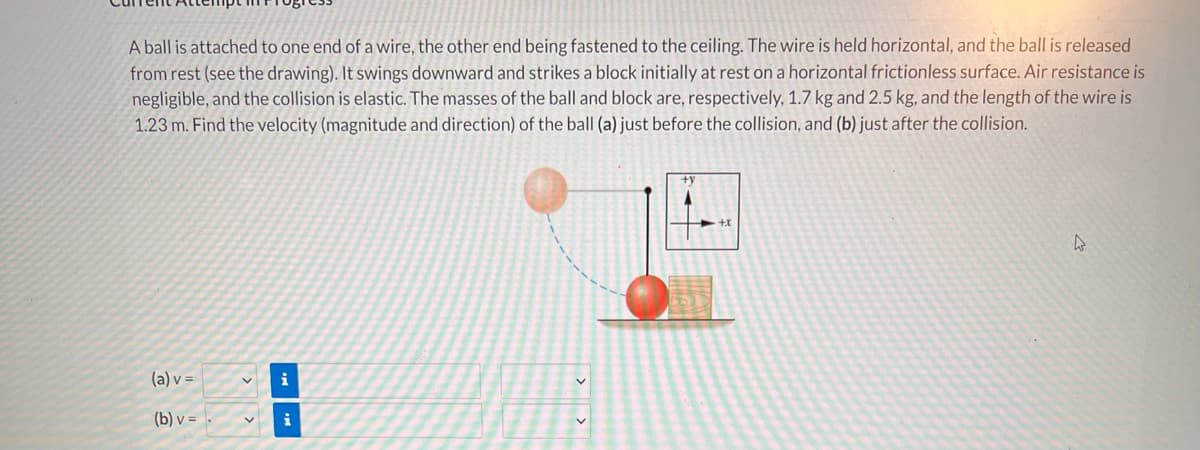A ball is attached to one end of a wire, the other end being fastened to the ceiling. The wire is held horizontal, and the ball is released from rest (see the drawing). It swings downward and strikes a block initially at rest on a horizontal frictionless surface. Air resistance is negligible, and the collision is elastic. The masses of the ball and block are, respectively, 1.7 kg and 2.5 kg, and the length of the wire is 1.23 m. Find the velocity (magnitude and direction) of the ball (a) just before the collision, and (b) just after the collision.
A ball is attached to one end of a wire, the other end being fastened to the ceiling. The wire is held horizontal, and the ball is released from rest (see the drawing). It swings downward and strikes a block initially at rest on a horizontal frictionless surface. Air resistance is negligible, and the collision is elastic. The masses of the ball and block are, respectively, 1.7 kg and 2.5 kg, and the length of the wire is 1.23 m. Find the velocity (magnitude and direction) of the ball (a) just before the collision, and (b) just after the collision.
Principles of Physics: A Calculus-Based Text
5th Edition
ISBN:9781133104261
Author:Raymond A. Serway, John W. Jewett
Publisher:Raymond A. Serway, John W. Jewett
Chapter8: Momentum And Collisions
Section: Chapter Questions
Problem 60P: A cannon is rigidly attached to a carriage, which can move along horizontal rails but is connected...
Related questions
Question

Transcribed Image Text:A ball is attached to one end of a vwire, the other end being fastened to the ceiling. The wire is held horizontal, and the ball is released
from rest (see the drawing). It swings downward and strikes a block initially at rest on a horizontal frictionless surface. Air resistance is
negligible, and the collision is elastic. The masses of the ball and block are, respectively, 1.7 kg and 2.5 kg, and the length of the wire is
1.23 m. Find the velocity (magnitude and direction) of the ball (a) just before the collision, and (b) just after the collision.
(a) v =
i
(b) v =
i
> >
Expert Solution
This question has been solved!
Explore an expertly crafted, step-by-step solution for a thorough understanding of key concepts.
This is a popular solution!
Trending now
This is a popular solution!
Step by step
Solved in 3 steps

Knowledge Booster
Learn more about
Need a deep-dive on the concept behind this application? Look no further. Learn more about this topic, physics and related others by exploring similar questions and additional content below.Recommended textbooks for you

Principles of Physics: A Calculus-Based Text
Physics
ISBN:
9781133104261
Author:
Raymond A. Serway, John W. Jewett
Publisher:
Cengage Learning

Physics for Scientists and Engineers: Foundations…
Physics
ISBN:
9781133939146
Author:
Katz, Debora M.
Publisher:
Cengage Learning

Principles of Physics: A Calculus-Based Text
Physics
ISBN:
9781133104261
Author:
Raymond A. Serway, John W. Jewett
Publisher:
Cengage Learning

Physics for Scientists and Engineers: Foundations…
Physics
ISBN:
9781133939146
Author:
Katz, Debora M.
Publisher:
Cengage Learning